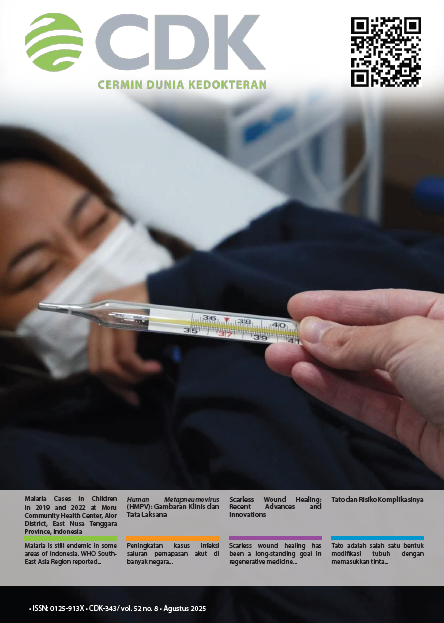Tato dan Risiko Komplikasinya
DOI:
https://doi.org/10.55175/cdk.v52i8.1584Kata Kunci:
Komplikasi, reaksi merugikan, tatoAbstrak
Tato adalah salah satu bentuk modifikasi tubuh dengan memasukkan tinta yang tidak terhapuskan ke dalam dermis untuk mengubah pigmen kulit. Berdasarkan durasi ketahanan pigmen, tato diklasifikasikan menjadi 2 jenis, yaitu tato temporer dan tato permanen. Peningkatan prevalensi pembuatan tato telah meningkatkan kesadaran terhadap reaksi merugikan yang terkait dengan tato, yang tidak terbatas pada risiko komplikasi dermatologis, namun juga sistemik. Reaksi merugikan terkait tato diklasifikasikan menjadi komplikasi infeksi, inflamasi, dan neoplasma. Risiko infeksi dan neoplasma pada tato temporer belum dilaporkan, hanya ditemukan pada tato permanen. Reaksi paling umum adalah reaksi hipersensitivitas terhadap pigmen tato, baik pada tato permanen maupun temporer. Risiko penularan infeksi pada pembuatan tato permanen beragam, dapat berupa infeksi bakteri, virus, jamur, dan parasit, dapat lokal dan sistemik. Risiko reaksi merugikan juga dilaporkan terkait dengan pigmen tato. Penelitian lebih lanjut diperlukan untuk mengidentifikasi hubungan kausal antara tato dan berbagai komplikasi kesehatan. Diperlukan kerangka regulasi standar untuk memastikan keamanan tinta tato.
Unduhan
Referensi
Adisa TA, Adekoya OD, Sani KF. Stigma hurts: exploring employer and employee perceptions of tattoos and body piercings in Nigeria. Career Development Internat. 2021;26(2):217–37. doi: 10.1108/CDI-09-2020-0239.
McCandlish C, Pearson M. Tattoos as symbols – an exploration of the relationship between tattoos and mental health. J Mental Health Training, Education Practice. 2023;18(3):217–27. doi: 10.1108/JMHTEP-07-2022-0057.
Al Hasan H. Profile of women who undergo tattoo in Basrah. Br J Multidisciplinary Advanced Studies. 2022;3(2):31–44. doi: https://doi.org/10.37745/bjmas.2022.0057.
Spurr A, Hanna N, Colantonio S. Cutaneous sarcoidosis in eyebrows cosmetically pigmented with microblading method: a case report and review of the literature. SAGE Open Med Case Rep. 2022;10: 2050313X221117720. doi: 10.1177/2050313X221117720.
Kiroshka K, Keiserman I. Multi-lamellar polychromatic keratopigmentation: a novel approach for corneal tattooing. Open Ophthalmol J. 2024;18(1):e18743641269201. doi: http://dx.doi.org/10.2174/0118743641269201240101104359.
Doganay D, Doganay S, Cankaya C. Corneal tattooing for esthetic purposes in patients with corneal opacities. Indian J Ophthalmol. 2020;68(6):1033-36. doi: 10.4103/ijo.IJO_1502_19.
Maselli D, Torreggiani M, Livieri T, Farioli G, Lucchi S, Guberti M. Tattooing to reconstruct nipple-areola complex after oncological breast surgery: a scoping review. Supportive Care Cancer. 2024;32(3):153. doi: 10.1007/s00520-024-08351-3.
Bassiouny D, Hegazy R, Esmat S, Gawdat HI, Ahmed Ezzat MA, Tawfik HA, et al. Cosmetic camouflage as an adjuvant to vitiligo therapies: effect on quality of life. J Cosmet Dermatol. 2021;20(1):159–65. doi: 10.1111/jocd.13459.
Kroger M, Schleusener J, Lademann J, Meinke MC, Jung S, Darvin ME. Tattoo pigments are localized intracellularly in the epidermis and dermis of fresh and old tattoos: in vivo study using two-photon excited fluorescence lifetime imaging. Dermatology. 2023;239(3):478–93. doi: 10.1159/000529577.
Weiß KT, Schreiver I, Siewert K, Luch A, Haslbock B, Berneburg M, et al. Tattoos – more than just colored skin? Searching for tattoo allergens. J Deutsch Dermatol Ges. 2021;19(5):657–69. doi: 10.1111/ddg.14436.
Mukkanna KS, Stone NM, Ingram JR. Para-phenylenediamine allergy: current perspectives on diagnosis and management. J Asthma Allergy. 2017;10:9–15. doi: 10.2147/JAA.S90265.
Minghetti P, Musazzi UM, Dorati R, Rocco P. The safety of tattoo inks: possible options for a common regulatory framework. Sci Total Environ. 2019;651:634–7. doi: 10.1016/j.scitotenv.2018.09.178.
Kluger N. Nickel and tattoos: where are we? Contact Dermatitis. 2021;85(2):136–40. doi: 10.1111/cod.13869.
Piccinini P, Pakalin S, Contor L, Bianchi I, Senaldi C. Safety of tattoos and permanent make-up: Final report. Cosemetics. 2016;8(2):47. doi: http://dx.doi.org/10.3390/cosmetics8020047.
Rogowska P, Szczerkowska‐Dobosz A, Kaczorowska R, Słomka J, Nowicki R. Tattoos: evaluation of knowledge about health complications and their prevention among students of Tricity universities. J Cosmet Dermatol. 2018;17(1):27–32. doi: 10.1111/jocd.12479.
Lim SH, Lee S, Lee YB, Lee CH, Lee JW, Lee SH, et al. Increased prevalence of transfusion-transmitted diseases among people with tattoos: a systematic review and meta-analysis. PLoS One. 2022;17(1):e0262990. doi: 10.1371/journal.pone.0262990.
Baleisis J, Rudys R. Comprehensive examination of tattoo removal using a 150 ps Nd:YAG laser in a porcine model. Sci Rep. 2023;13(1):13062. doi: 10.1038/s41598-023-40379-z.
Khunger N, Molpariya A, Khunger A. Complications of tattoos and tattoo removal: stop and think before you ink. J Cutan Aesthet Surg. 2015;8(1):30-6. doi: 10.4103/0974-2077.155072.
Brown H, Hannaford R. Recurrent lichenoid reaction to black tattoo ink: a case report and brief review of the literature. Australas J Dermatol. 2020;61(2):e238-40. doi: 10.1111/ajd.13231.
Kluger N. Self‐reported tattoo reactions in a cohort of 448 French tattooists. Int J Dermatol. 2016;55(7):764–8. doi: 10.1111/ijd.13030.
Kluger N. Cutaneous and systemic complications associated with tattooing. Presse Med. 2016;45(6):567–76. doi: 10.1016/j.lpm.2016.02.016.
Nielsen C, Andreasson K, Olsson H, Engfeldt M, Joud A. Cohort profile: The Swedish tattoo and body modifications cohort (TABOO). BMJ Open. 2023;13(5):e069664. doi: 10.1136/bmjopen-2022-069664.
Khodadost M, Maajani K, Arabsalmani M, Mahdavi N, Tabrizi R, Alavian SM. Is tattooing a risk factor for hepatitis c transmission?: an updated systematic review and meta-analysis. Hepat Mon. 2017;17(9): e14308. doi: 10.5812/hepatmon.14308.
Liou YL, Voller LM, Liszewski W, Ericson ME, Siegel PD, Warshaw EM. Formaldehyde release from predispersed tattoo inks: analysis using the chromotropic acid method. Dermatitis. 2021;32(5):327–32. doi: 10.1097/DER.0000000000000663.
Balaceanu-Gurau B, Apostol E, Caraivan M, Ion A, Tatar R, Mihai MM, et al. Cutaneous adverse reactions associated with tattoos and permanent makeup pigments. J Clin Med. 2024;13(2):503. doi: 10.3390/jcm13020503.
Ferrari DM, Hoffmann JC, Schon MP, Lippert U. Efficient removal of black henna tattoos. Pediatr Dermatol. 2020;37(6):1063–7. doi: 10.1111/pde.14349.
Calogiuri G, Di Leo E, Butani L, Pizzimenti S, Incorvaia C, Macchia L, et al. Hypersensitivity reactions due to black henna tattoos and their components: are the clinical pictures related to the immune pathomechanism? Clin Mol Allergy. 2017;15:8. PMID: 28400706.
Polat M, Şasmaz S. Contact dermatitis after temporary henna tattoo. Gazi Med J. 2015;26(1):24-5. doi: 10.12996/gmj.2015.08.
Serrano-Serra JP, Montero-Vilchez T, Buendia-Eisman A, Arias-Santiago S. Epidermal barrier function and skin homeostasis in skin with permanent and adhesive tattoos: a cross-sectional study. J Clin Med. 2021;10(4):888. doi: 10.3390/jcm10040888.
Huisman S, van der Bent SAS, Maijer KI, Tio DCKS, Rustemeyer T. Cutaneous non-allergic complications in tattoos: an overview of the literature. Presse Med. 2020;49(4):104049. doi: 10.1016/j.lpm.2020.104049.
Kluger N. Systemic diseases and infections, anecdotal complications and oddities associated with tattooing. Presse Med. 2020;49(4):104055. doi: 10.1016/j.lpm.2020.104055.
Laux P, Tralau T, Tentschert J, Blume A, Dahouk S Al, Baumler W, et al. A medical-toxicological view of tattooing. Lancet. 2016;387(10016):395–402. doi: 10.1016/s0140-6736(15)60215-x.
Serup J, Sepehri M, Hutton Carlsen K. Classification of tattoo complications in a hospital material of 493 adverse events. Dermatology. 2016;232(6):668–78. doi: 10.1159/000452148.
Oyen EMM, Maijer KI, van der Bent SAS, Prins JM, Janssen S, Kuipers S, et al. Spontaneous resolution of multidrug‐resistant Mycobacterium abscessus infection in tattoo. J Eur Acad Dermatol Venereol. 2021;35(5): e328-30. doi: 10.1111/jdv.17072.
Schwob E, Kluger N. Dermatophytose sur des tatouages récents. Ann Dermatol Venereol. 2020;147(10):637–42. doi: 10.1016/j.annder.2020.04.019.
Simunovic C, Shinohara MM. Complications of decorative tattoos: recognition and management. Am J Clin Dermatol. 2014;15(6):525–36. doi: 10.1007/s40257-014-0100-x.
Kluger N, Saarinen K. Aspergillus fumigatus infection on a home-made tattoo. Br J Dermatol. 2014;170(6):1373–5. doi: 10.1111/bjd.12859.
Fauger A, Sonck S, Kluger N, Chavagnac‐Bonneville M, Sayag M. Tattoo aftercare management with a dermo‐cosmetic product: improvement in discomfort sensation and skin repair quality. J Cosmet Dermatol. 2022;21(3):1051–6. doi: 10.1111/jocd.14157.
Hayat S, Cho Y, Oh S, Yoo H. RF-Induced heating of various tattoos at magnetic resonance imaging systems. IEEE Access. 2021;9:100951–61. doi: 10.1109/ACCESS.2021.3097145.
Kluger N, Brun‐Leveque P, Gral N. Painful burning sensation on a tattoo during magnetic resonance imaging. Int J Dermatol. 2019;58(4): E82-3. doi: 10.1111/ijd.14403.
Serup J, Alsing KK, Olsen O, Koch CB, Hansen RH. On the mechanism of painful burn sensation in tattoos on magnetic resonance imaging (MRI). Magnetic substances in tattoo inks used for permanent makeup (PMU) identified: magnetite, goethite, and hematite. Skin Res Technol. 2023;29(3):e13281. doi: 10.1111/srt.13281.
Chalarca-Canas D, Caviedes-Cleves MA, Correa-Londono LA, Ospina-Gomez JP, Velasquez-Lopera MM. Tattoos: risks and complications, clinical and histopathological approach. An Bras Dermatol. 2024;99(4):491–502. doi: 10.1016/j.abd.2023.07.004.
Kluger N. Cutaneous complications related to tattoos: 31 cases from Finland. Dermatology. 2017;233(1):100–9. doi: 10.1159/000468536.
Hutton Carlsen K, Serup J. Photosensitivity and photodynamic events in black, red and blue tattoos are common: a ‘beach study’. J Eur Acad Dermatol Venereol. 2014;28(2):231–7. doi: 10.1111/jdv.12093.
Orzan OA, Dorobanțu AM, Gurău CD, Ali S, Mihai MM, Popa LG, et al. Challenging patterns of atypical dermatofibromas and promising diagnostic tools for differential diagnosis of malignant lesions. Diagnostics. 2023;13(4):671. doi: 10.3390/diagnostics13040671.
Kluger N. Tattooing and psoriasis: demographics, motivations and attitudes, complications, and impact on body image in a series of 90 Finnish patients. Acta Dermatovenerol Alp Pannonica Adriat. 2017;26(2):29-32. doi: 10.15570/actaapa.2017.9.
Serup J, Carlsen KH, Sepehri M. Tattoo complaints and complications: diagnosis and clinical spectrum. Curr Probl Dermatol. 2015;48:48-60. doi: 10.1159/000369645.
Islam PS, Chang C, Selmi C, Generali E, Huntley A, Teuber SS, et al. Medical complications of tattoos: a comprehensive review. Clin Rev Allergy Immunol. 2016;50(2):273–86. doi: 10.1007/s12016-016-8532-0.
Unduhan
Diterbitkan
Cara Mengutip
Terbitan
Bagian
Lisensi
Hak Cipta (c) 2025 Putu Ayu Krisna Cahyaning Putri, Putu Dyah Ayu Saraswati

Artikel ini berlisensi Creative Commons Attribution-NonCommercial 4.0 International License.





















